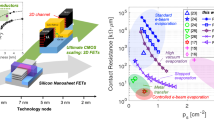Abstract
Herein we describe theoretical and experimental analysis of the source resistance (Rs) components in In0.7Ga0.3As/In0.52Al0.48As quantum-well (QW) high-electron-mobility transistors (HEMTs) on an InP substrate. First, we analytically modeled Rs using a three-layer formula, separately modeling the regions of the ohmic contact, the gate-to-source access, and the side-recessed regions. The resistances of the ohmic contact and access regions were analyzed in a distributed-network manner with two different transfer lengths, whereas the resistance associated with the side-recess region near the gate edge was modeled by using a lumped element. To verify the accuracy of the proposed Rs model, we fabricated two different types of transmission-line-method (TLM) test patterns as well as long-channel In0.7Ga0.3As/In0.52Al0.48As QW HEMTs, and compared their measured and modeled Rs. The modeled Rs was in excellent agreement with the measured Rs from the recessed TLM patterns and the long-channel HEMTs. Since the widths of the ohmic contact to the heavily doped In0.53Ga0.47As capping layer and the gate-to-source access region were typically much greater than corresponding transfer lengths (\(L_{{{\text{T}}\_{\text{cap}}}}\) and \(L_{{{\text{T}}\_{\text{barrier}}}}\)), those distributed networks could be simplified to a lumped-element based one-layer model, revealing that the tunneling resistance (\(R_{{{\text{barrier}}}}\)) through the In0.52Al0.48As barrier should be carefully considered to minimize the Rs of InxGa1−xAs QW HEMTs together with S/D contact resistances and LGS.








Similar content being viewed by others
References
E.-Y. Chang, C.-I. Kuo, H.-T. Hsu, C.-Y. Chiang, Y. Miyamoto, InAs thin-channel high-electron-mobility transistors with very high current-gain cutoff frequency for emerging submillimeter-wave applications. Appl. Phys. Express 6(3), 34001 (2013)
X. Mei et al., First demonstration of amplification at 1 THz using 25-nm InP high electron mobility transistor process. IEEE Electron Dev. Lett. 36(4), 327–329 (2015)
A. Leuther et al., 20 NM metamorphic HEMT with 660 GHZ FT, in Int. Conf. on IPRM (2011)
H.-B. Jo et al., Lg = 25 nm InGaAs/InAlAs high-electron mobility transistors with both fT and fmax in excess of 700 GHz. Appl. Phys. Express 12(5), 54006 (2019)
M.W. Pospieszalski, Extremely low-noise amplification with cryogenic FETs and HFETs: 1970–2004. IEEE Microw. Mag. 6(3), 62–75 (2005)
M.W. Pospieszalski, On the limits of noise performance of field effect transistors, in 2017 IEEE MTT-S International Microwave Symposium (IMS), pp. 1953–1956 (2017)
T. Enoki, K. Arai, A. Kohzen, Y. Ishii, Design and characteristics of InGaAs/InP composite-channel HFET’s. IEEE Trans. Electron Dev. 42(8), 1413–1418 (1995)
H. Sugiyama, H. Matsuzaki, H. Yokoyama, T. Enoki, High-electron-mobility In0.53Ga0.47As/In0.8Ga0.2As composite-channel modulation-doped structures grown by metal-organic vapor-phase epitaxy, in Int. Conf. on IPRM (2010)
P.J. Tasker, B. Hughes, Importance of source and drain resistance to the maximum fT of millimeter-wave MODFETs. IEEE Electron Dev. Lett. 10(7), 291–293 (1989)
T. Takahashi, K. Makiyama, N. Hara, M. Sato, T. Hirose, Improvement in high frequency and noise characteristics of InP-based HEMTs by reducing parasitic capacitance, in Int. Conf. on IPRM (2008)
K. Akagawa, S. Fukuda, T. Suemitsu, T. Otsuji, H. Yokohama, G. Araki, Impact of T-gate electrode on gate capacitance in In0.7Ga0.3As HEMTs. Phys. Status Solidi c 8(2), 300–302 (2011)
H. Fukui, Optimal noise figure of microwave GaAs MESFET’s. IEEE Trans. Electron Dev. 26(7), 1032–1037 (1979)
K.J. Chen, T. Enoki, K. Maezawa, K. Arai, M. Yamamoto, High-performance InP-based enhancement-mode HEMTs using non-alloyed ohmic contacts and Pt-based buried-gate technologies. IEEE Trans. Electron Dev. 43(2), 252–257 (1996)
N. Waldron, D. Kim, J.A. del Alamo, A self-aligned InGaAs HEMT architecture for logic applications. IEEE Trans. Electron Dev. 57(1), 297–304 (2010)
E. Cha, N. Wadefalk, G. Moschetti, A. Pourkabirian, J. Stenarson, J. Grahn, InP HEMTs for sub-mW cryogenic low-noise amplifiers. IEEE Electron Dev. Lett. 41(7), 1005–1008 (2020)
T. Takahashi et al., Enhancement of fmax to 910 GHz by adopting asymmetric gate recess and double-side-doped structure in 75-nm-gate InAlAs/InGaAs HEMTs. IEEE Trans. Electron Dev. 64(1), 89–95 (2017)
D. Yun et al., Impact of the source-to-drain spacing on the DC and RF characteristics of InGaAs/InAlAs high-electron mobility transistors. IEEE Electron Dev. Lett. 39(12), 1844–1847 (2018)
H. Matsuzaki, T. Maruyama, T. Koasugi, H. Takahashi, M. Tokumitsu, T. Enoki, Lateral scale down of InGaAs/InAs composite-channel HEMTs with tungsten-based tiered ohmic structure for 2-S/mm gm and 500-GHz fT. IEEE Trans. Electron Dev. 54(3), 378–384 (2007)
H. Sugiyama et al., High-performance InGaAs/InP composite-channel high electron mobility transistors grown by metal-organic vapor-phase epitaxy. Jpn. J. Appl. Phys. 47(4), 2828–2832 (2008)
M.D. Feuer, Two-layer model for source resistance in selectively doped heterojunction transistors. IEEE Trans. Electron Dev. 32(1), 7–11 (1985)
S.M. Baier, M.S. Shur, K. Lee, N.C. Cirillo, S.A. Hanka, FET Characterization using gated-TLM structure. IEEE Trans. Electron Dev. 32(12), 2824–2829 (1985)
Acknowledgments
This work was supported by the Technology Innovation Program (20010879, The technology development of device, process and circuit based on InP for ultra low noise amplifier MMIC) funded By the Ministry of Trade, Industry & Energy (MOTIE, Korea) and by the BK21 Plus project funded by the Ministry of Education, Korea (21A20131600011).
Author information
Authors and Affiliations
Corresponding authors
Additional information
Publisher's Note
Springer Nature remains neutral with regard to jurisdictional claims in published maps and institutional affiliations.
Rights and permissions
About this article
Cite this article
Lee, IG., Ko, DH., Yun, SW. et al. Theoretical and experimental analysis of the source resistance components in In0.7Ga0.3As quantum-well high-electron-mobility transistors. J. Korean Phys. Soc. 78, 516–522 (2021). https://doi.org/10.1007/s40042-021-00096-0
Received:
Revised:
Accepted:
Published:
Issue Date:
DOI: https://doi.org/10.1007/s40042-021-00096-0




